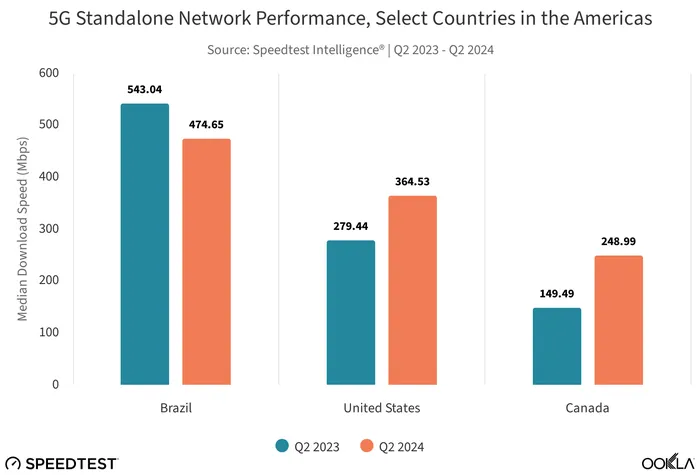Ookla said its data shows less than one in four 5G subscribers are connecting to 5G standalone networks in the US. The difference in download speeds is just another feather in T-Mobile’s cap as competitors scramble to keep up.
Although 5G standalone (5G SA) networks aren’t yet the norm in the US, they are delivering higher download speeds that are steadily improving, according to data shared this week by Ookla.
That’s not the case in all countries. Ookla has noted cases where some 5G SA download speeds have dropped as more customers are loaded onto carrier networks. But in the US, the median download speeds keep going up, thanks in part to additional spectrum added by T-Mobile early this year.
According to Ookla, the median download speed for 5G non-standalone (5G NSA) in the US was 170.90 Mbit/s in Q2 2024. Without breaking down the individual networks, Ookla found the median 5G SA download speed in the US was 364.53 Mbit/s during that same quarter.
Ookla’s data is based on devices running its Speedtest app; when the app runs a test, Ookla can tell what network a device is connected to while checking its speed. “Our data shows that there were 4.3 times more users on 5G NSA than on 5G SA in the United States,” wrote Karim Yaici, industry analyst at Ookla, in response to questions from Light Reading.

(Source: Ookla)
The 5G SA race for US nationwide carriers is between T-Mobile and EchoStar’s Boost Mobile (formerly Dish Wireless). Boost’s greenfield open RAN 5G SA network covers 99% of the US population but still includes roaming coverage from partner networks. UScellular has also deployed 5G SA, but it doesn’t cover the entire country, and it’s being bought by T-Mobile.
While the network speed may not matter much to consumers in most cases, it has always been a talking point with carrier marketing departments. Regarding 5G SA, T-Mobile is doing all the talking as analysts agree it has better 5G coverage thanks to its lower frequency spectrum, reaching more locations while providing coverage in buildings and homes.
As covered this week, Opensignal’s recent glimpse at “what proportion of time people have a network connection, in places they most commonly frequent” shows T-Mobile as being well ahead of AT&T and Verizon in 5G reach as perceived by customers.
D2D and 5G
Even without 5G SA networks, 5G customers may get better coverage soon thanks to several carrier partnerships and investments in satellite direct-to-device (D2D) coverage. The satellite coverage will help increase 5G’s reach and could boost consumers’ feelings about their coverage.
That reach will also factor into carriers being able to offer new kinds of services. A new path to revenues is also the motivation behind much of the 5G network spending, though there is a ceiling for what a 5G network can do without a standalone 5G core.
“Beyond speed, 5G SA promises new capabilities, such as network slicing, that have started to emerge in the most advanced markets but will take time to become a reality for most consumers and enterprises worldwide,” wrote Ookla’s Yaici in a blog post earlier this week.
Original article can be seen at:
